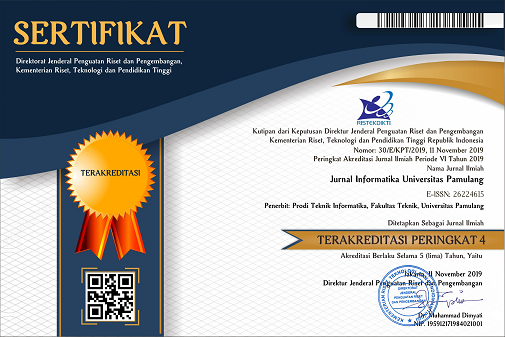Penggunaan ICT dalam Penyusunan Modul Statistika
DOI:
https://doi.org/10.32493/informatika.v3i3.2128Keywords:
Development, modules, statistics, ADDIE, ICTAbstract
In this study, the objectives to be achieved are teaching material products in the form of information technology-based statistical modules (Information and communication technology). This study uses the development of the ADDIE model in the preparation of the module. The ADDIE model consists of analysis (analysis), design (design), development (development), implementation (implementation) and the last is evaluation (evaluation). In the ADDIE model, the module developed contains valid, practical and effective criteria. Validity criteria refer to the validity of experts and practitioners. For the practicality of modules developed, based on the instrument in the form of a questionnaire. While for module effectiveness, it can be seen from the value of student achievement. The results of this study indicate that the modules developed meet valid criteria which fall into the very good category. For the module practicality criteria, the research shows that the module falls into a very good category based on the observations of the implementation of lecturers' learning and assessment. Based on student responses, the developed statistical modules fall into the good category. As for the effectiveness category, based on student achievement, the module can be classified as effective.
References
Branch, R. M. (2009). Instructional design: The ADDIE approach (Vol. 722). New York: Springer Science & Business Media.
Chance, B., delMas, R., & Garfield, J. (2004). Reasoning about sampling distributions. In D. Ben-Zvi & J. Garfield (Eds.). The challenge of developing statistical literacy, reasoning, and thinking (pp. 295 – 323).
Furqon, P. D. (1999). Statistika terapan untuk penelitian. Alfabeta, Bandung.
Gasperz, V, Statistical Process Control, PT Gramedia Pustaka Utama, Jakarta 1998.
Kusumah, Y. S. (2011). Aplikasi Teknologi Informasi dan Komunikasi dalam Pembelajaran Matematika untuk Meningkatkan Kemampuan Matematis Siswa. Makalah disajikan dalam Kegiatan Pelatihan Aplikasi Teknologi dan Komunikasi dalam Pembelajaran Matematika, 16.
Kwartolo, Y. (2010). Teknologi informasi dan komunikasi dalam proses pembelajaran. Jurnal Pendidikan Penabur, 14, 15-43.
Leibman, Zipora. (2010). Integrating Real Life Data Analysis in Teaching Descriptive Statistics: A Constructivist Approach. Journal of Statistic Education. 18, (1). www.amstat.org/publications/jse/v18n1/libman.pdf
Pribadi, B. A. (2009). Model desain sistem pembelajaran. Jakarta: Dian Rakyat
Purwati, A. D. (2016). Developing English Learning Materials for the 3rd Semester Students of Informatics Engineering Education Program at Yogyakarta State University. Skripsi S1 di Universitas Negeri Yogyakarta tahun 2016.
Purwanto, J. (2003). Dasar-dasar Metode Penarikan Sampel. Materi kuliah Metode Penarikan Contoh Sekolah Tinggi Ilmu Statistik (STIS). Jakarta.
Somantri, A., & Muhidin, S. A. (2006). Aplikasi Statistika dalam penelitian. Bandung: Pustaka Setia
Sundayana, R. (2012). Pengaruh Perkuliahan Statistika Berbantuan Ms. Excel dan SPSS dengan Model Pembelajaran Tutorial Terhadap Kemampuan Pemecahan Masalah dan Komunikasi Matematis. Universitas Pendidikan Indonesia: Respository. UPI, edu.
Suyanto, E. (2010). Pembelajaran Berbasis ICT. Bandar Lampung.
Warsita, B. (2008). Teknologi Pembelajaran Landasan dan Aplikasinya . Jakarta: Rineka Cipta.
Widoyoko, E. P. (2009). Evaluasi Program Pendidikan. Yogyakarta: Pustaka Belajar.
Downloads
Published
Issue
Section
License
Authors who publish with this journal agree to the following terms:
- Authors retain copyright and grant the journal right of first publication with the work simultaneously licensed under a Creative Commons Attribution-NonCommercial 4.0 International (CC BY-NC 4.0) that allows others to share the work with an acknowledgement of the work's authorship and initial publication in this journal.
- Authors are able to enter into separate, additional contractual arrangements for the non-exclusive distribution of the journal's published version of the work (e.g., post it to an institutional repository or publish it in a book), with an acknowledgement of its initial publication in this journal.
- Authors are permitted and encouraged to post their work online (e.g., in institutional repositories or on their website) prior to and during the submission process, as it can lead to productive exchanges, as well as earlier and greater citation of published work (See The Effect of Open Access).
Jurnal Informatika Universitas Pamulang have CC-BY-NC or an equivalent license as the optimal license for the publication, distribution, use, and reuse of scholarly work.
In developing strategy and setting priorities, Jurnal Informatika Universitas Pamulang recognize that free access is better than priced access, libre access is better than free access, and libre under CC-BY-NC or the equivalent is better than libre under more restrictive open licenses. We should achieve what we can when we can. We should not delay achieving free in order to achieve libre, and we should not stop with free when we can achieve libre.
Jurnal Informatika Universitas Pamulang is licensed under a Creative Commons Attribution-NonCommercial 4.0 International (CC BY-NC 4.0)
YOU ARE FREE TO:
- Share : copy and redistribute the material in any medium or format
- Adapt : remix, transform, and build upon the material for any purpose, even commercially.
- The licensor cannot revoke these freedoms as long as you follow the license terms





